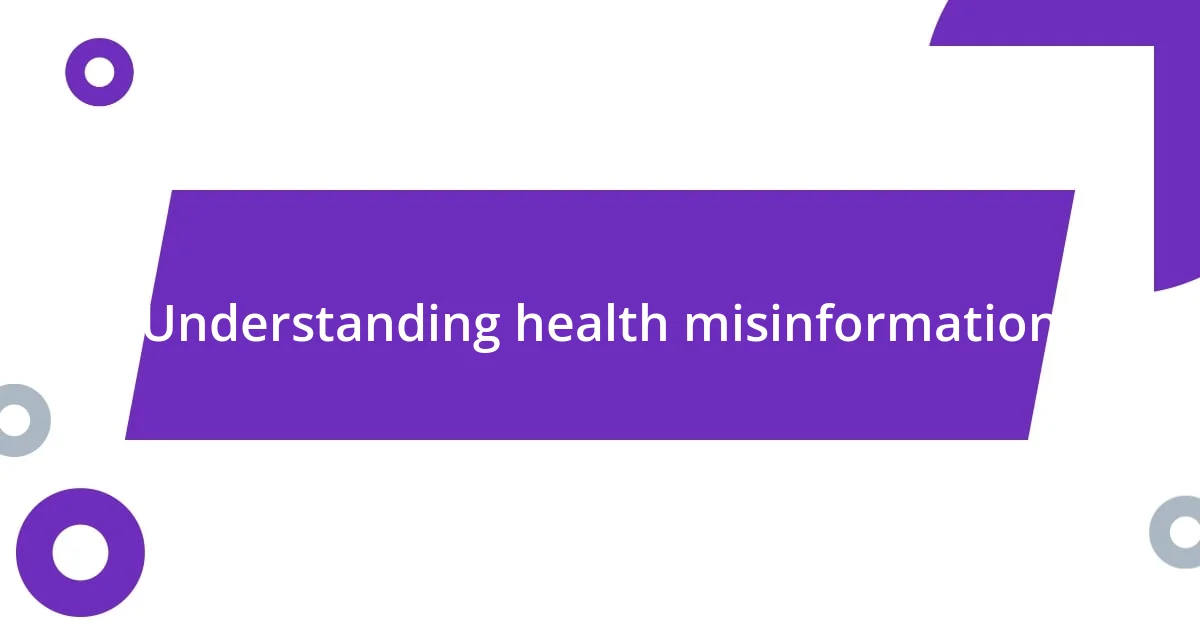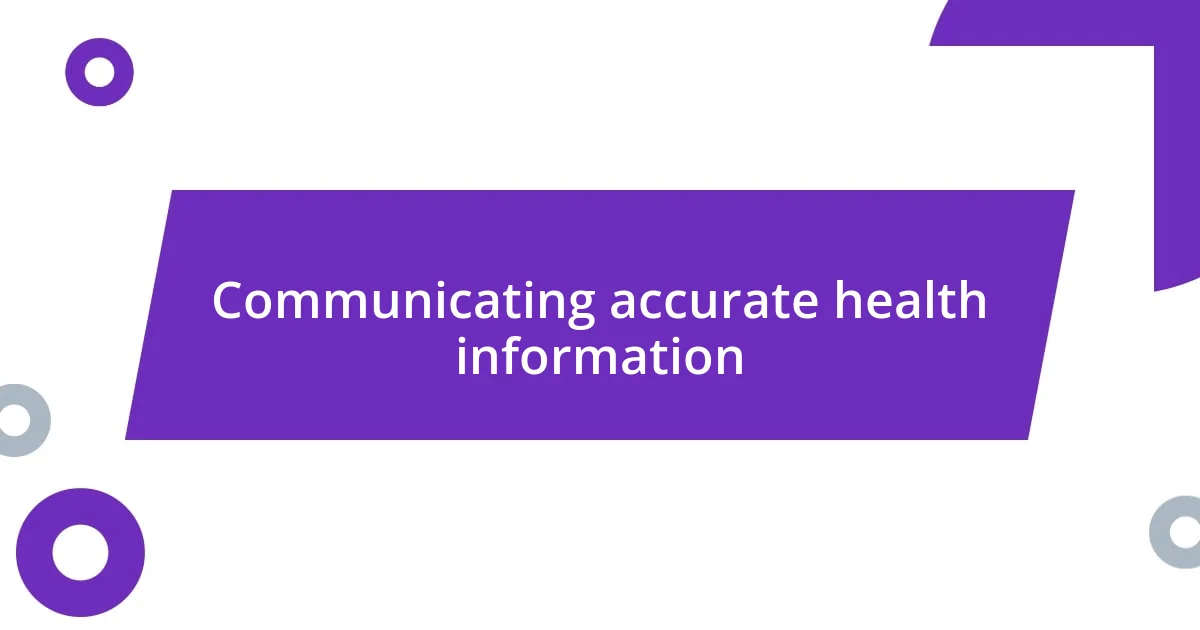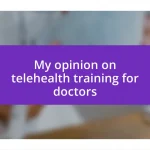Key takeaways:
- Health misinformation spreads rapidly through social media, often leading to panic and misconceptions about health issues.
- Identifying common health myths, like those surrounding vaccines and sugar, is critical for informed decision-making and combating fear-based narratives.
- Engaging the community through workshops and open discussions fosters health literacy, empowering individuals to seek credible information and challenge misconceptions.

Understanding health misinformation
When it comes to health misinformation, it’s striking how easily false information can spread, often fueled by fear or sensational headlines. I remember when a close friend panicked after reading a Facebook post about a supposed health risk she believed was looming over her. It made me realize just how much influence social media has, and how quickly misinformation can distort our understanding of health issues.
One alarming aspect is that many people don’t even realize they’re consuming misinformation. Have you ever clicked on a headline that seemed too outrageous to be true? I know I have, and it didn’t take long before I had to sift through facts to find the reality. Health topics are often complex, and the nuances can get lost in translation, leading to misconceptions that can impact decisions around healthcare.
What fascinates me is how sometimes misinformation can create a sense of community, often based on shared fears or beliefs. I once found myself in an online group where members rallied around a particular health scare, only to later discover that the foundation of their worries was not grounded in fact. This experience highlighted how, without critical thinking, even well-meaning individuals can be swayed by misleading information, showcasing the importance of education in discerning credible sources.

Identifying common health myths
Identifying common health myths is essential for navigating the often murky waters of health misinformation. I recall an instance when someone suggested that drinking excessive water would detoxify the body completely. At first, I was intrigued, but a little research revealed that it’s possible to consume too much water, leading to dangerously low sodium levels. The realization hit me: even seemingly harmless advice can have serious consequences if taken at face value.
Another common myth I came across is the belief that vaccines cause autism. This misconception, which originated from a flawed study that has since been discredited, perpetuates unnecessary fear around vaccination. When I talked to a parent who feared vaccinating their child, I could see the genuine concern rooted in unfounded beliefs, reminding me how important it is to communicate facts that reassure rather than instill fear.
Interestingly, the myth that sugar causes hyperactivity in children is widely believed. I’ve had moments in parenting where I wondered about this too, especially after my kids had a birthday party filled with sweets. But research suggests that the sugar-hyperactivity link is largely a misconception fueled by expectations. This experience taught me the power of questioning popular beliefs and looking beyond what seems obvious.
| Health Myth | Truth |
|---|---|
| Drinking excessive water detoxifies the body | Too much water can lead to health risks, like hyponatremia. |
| Vaccines cause autism | Studies have shown no link between vaccines and autism. |
| Sugar causes hyperactivity in children | Research indicates no direct correlation. |

Evaluating credible sources
To effectively evaluate credible sources, I rely on a few key strategies. One of the most crucial steps is checking the author’s qualifications and background. For instance, when I stumbled upon an article promoting a questionable diet, I noticed the author had no relevant medical training. It struck me how easily we can be misled by an appealing narrative when it lacks credible expertise.
Here are some essential points to consider when assessing a source:
-
Author Credentials: Look for qualifications, such as degrees or professional experience in health fields.
-
Publication: Assess the reputation of the website or journal; peer-reviewed sources are generally trustworthy.
-
References and Evidence: A credible source will provide references to scientific studies and data, not just anecdotal evidence.
-
Date of Publication: Health information evolves quickly, so ensure the content is up-to-date.
-
Bias and Objectivity: Consider whether the source has a financial interest in promoting an idea or product.
Recently, I encountered an article about a trending supplement that promised miraculous results. The more I investigated, the more I noticed the source seemed to have strong ties to the supplement’s manufacturer. This experience reinforced my belief that recognizing conflicts of interest is just as vital as understanding the information itself. It’s essential to remain vigilant and discerning, as our health decisions hinge on the accuracy of the information we consume.

Strategies for fact-checking claims
When it comes to fact-checking health claims, I often start by using reputable databases and resources, like PubMed or the Cochrane Library. I remember a time when a friend shared an article that claimed a miracle cure for a common cold. Instead of just accepting it, I took a few minutes to search these databases. What struck me was how quickly I could find scientific studies debunking the myth. Have you ever thought about how a few minutes of digging could save you from following harmful advice?
I also recommend checking multiple sources before drawing conclusions. There was a period when I was bombarded with information about a new superfood. Each article seemed convincing in its own right, yet they all cited different research. By taking the time to compare these claims, I realized some sources exaggerated the benefits while ignoring potential risks. It made me ponder: how often do we skip this extra step and settle for the first piece of information that aligns with our beliefs?
Finally, integrating community insights can be incredible for evaluating health claims. I’ve often turned to forums and social media groups for firsthand accounts, but I always approach these with caution. For instance, while discussing a new health trend, several people shared their experiences, but only a few provided evidence to support their claims. It was eye-opening to see how emotional experiences often overshadow factual accuracy. This reminds me to ask myself: are we sometimes more eager to share what feels right rather than what is right? Checking in with emotions can be a great guide, but they shouldn’t replace diligent fact-checking.

Communicating accurate health information
Sure! Here are the paragraphs focusing on “Communicating accurate health information”:
When I share health information, I always think about the delivery method. I recall a webinar I attended where the speaker used vivid visuals and clear language to explain complex topics. This approach not only made the information accessible but also kept me engaged. It’s incredible to consider how effective communication can bridge the gap between scientific jargon and everyday understanding. Have you noticed how a good story can make tough concepts feel relatable?
Another key aspect I emphasize is listening. I often engage in discussions about health on social media. In one conversation, a follower was adamant about a new diet trend without evidence. Rather than shutting down the conversation, I asked questions that encouraged them to explore their beliefs. This not only created a safe space for dialogue but also prompted them to seek out credible information themselves. I find that open communication can spark curiosity, leading to more informed choices.
Lastly, I lean on the power of simplification. For example, I’ve created infographics to break down complicated health metrics. When I first shared one about blood pressure, friends who once felt overwhelmed by medical terms suddenly grasped the core principles. It’s rewarding to witness that “aha!” moment. How often do we underestimate the value of making information digestible? In my experience, simple, clear messages resonate longer and better than complex information.

Engaging with the community
Engaging with the community has been one of the most rewarding aspects of tackling health misinformation. I vividly remember a local health fair where I set up a booth focused on myth-busting. As I interacted with attendees, many shared their fears and misconceptions about vaccinations. Listening to their stories reminded me that information isn’t just facts; it’s often intertwined with personal experiences and emotions. How often do we engage with someone only to realize their worries stem from a place of genuine concern?
I also find that participating in local online groups can be a game-changer. Once, a discussion erupted about dietary supplements that claimed to be “all-natural.” Instead of simply arguing the science, I shared my own journey with dietary changes—how some made me feel great while others had unexpected drawbacks. This opened up a dialogue that encouraged others to share their experiences, too. It made me think: what if we all approached these conversations with vulnerability and authenticity?
Moreover, I believe that community events can serve as an excellent platform for education. I once hosted a workshop that addressed common health myths, and the energy in the room was palpable. Participants were asking questions, sharing their experiences, and even challenging some of the information presented. It was enlightening to witness how a supportive environment fosters curiosity and critical thinking. Isn’t it fascinating how a just few conversations can ripple through a community, leading to more informed public discussions around health?

Promoting health literacy initiatives
Promoting health literacy initiatives is crucial in our fight against misinformation. I once organized a series of workshops at a community center, targeting parents who were unsure about their children’s vaccinations. Seeing their faces transform from skepticism to understanding was fulfilling. As they became more informed, I sensed a shift in their confidence, and it made me realize how much we underestimate the power of knowledge. Isn’t it uplifting to think that a few facts can change someone’s perspective?
I also launched an online campaign that encouraged people to share their health questions anonymously. One question that stood out was about the myths surrounding herbal remedies. In my response, I emphasized the importance of consulting healthcare professionals rather than relying solely on anecdotal evidence. It was thrilling to see how this approach sparked interest, leading to further inquiries and deeper conversations among participants. Have you ever considered how vulnerability in sharing can break down barriers to learning?
Another initiative I championed was partnering with local schools to create health literacy programs for teens. During one session, a student passionately challenged a popular myth about nutrition. Rather than dismissing her viewpoint, I encouraged an open debate. The energy in the room was infectious, and it reminded me how vital it is to involve young voices in these discussions. When we empower the next generation, don’t we pave the way for a future with informed adults?














